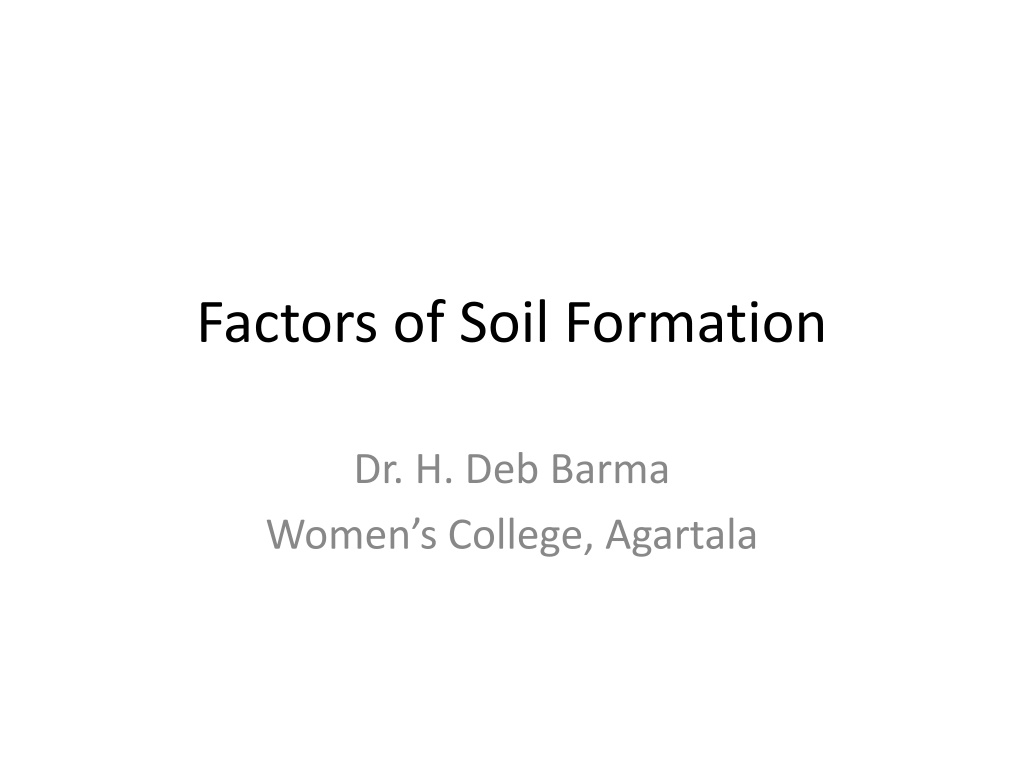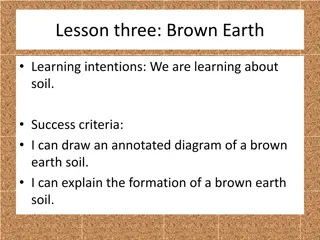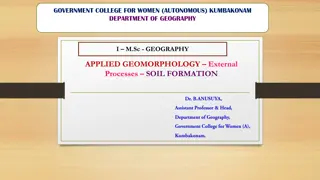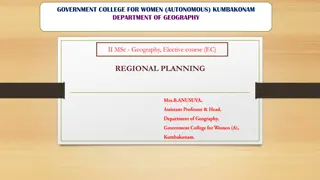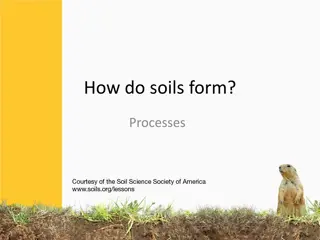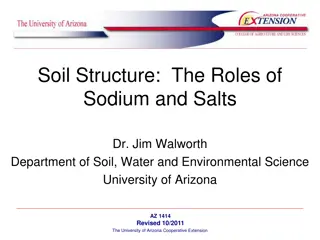Understanding Factors of Soil Formation and Soil Geography
Soil formation is a complex process influenced by factors like weathering, organic matter, and minerals. Soil geography studies soil distribution using geographic methods and cartography. Various definitions of soil highlight its importance for plant growth and as a natural body with distinct horizons. The transformation of rocks into soil is crucial in agriculture and environmental science.
Uploaded on Sep 21, 2024 | 0 Views
Download Presentation

Please find below an Image/Link to download the presentation.
The content on the website is provided AS IS for your information and personal use only. It may not be sold, licensed, or shared on other websites without obtaining consent from the author. Download presentation by click this link. If you encounter any issues during the download, it is possible that the publisher has removed the file from their server.
E N D
Presentation Transcript
Factors of Soil Formation Dr. H. Deb Barma Women s College, Agartala
Soil Geography Soil geography relies principally on the compa rative geographic method to study the distribu tion of soils in relation to the factors influencin g soil formation. Extensive use is made of cart ography in the compilation of soil maps.
Soil The topmost layer of land which is composed of grainy substance is called soil. The soil is made up of organic matter, minerals and weathered rocks. Soil formation takes place because of weathering of rocks. The soil becomes fertile because of the right combination of minerals and organic matter. Preliminary Definitions of Soil. In the layman's mind, the soil is a very concrete thing, namely, the "dirt" on the surface of the earth. To the soil scientist, or pedologist, the word "soil" conveys a somewhat different meaning, but no generally accepted definition exists.
Hilgard defined soil as "the more or less loose and friable material in which, by means of their roots, plants may or do find a foothold and nourishment, as well as other conditions of growth." This is one of the many definitions that consider soil primarily as a means of plant production. Ramann writes: "The soil is the upper weathering layer of the solid earth crust." This definition is scientific in the sense that no reference is made to crop production or to any other utilitarian motive. Joffe, a representative of the Russian school of soil science, objects to Ramann's formulation on the grounds that it does not distinguish between soil and loose rock material.
According to Joffe, The soil is a natural body, differentiated into horizons of mineral and organic constituents, usually unconsolidated, of variable depth, which differs from the parent material below in morphology, physical properties and constitution, chemical properties and composition, and biological characteristics. It is problematic whether any definition of soil could be formulated to which everyone would agree. Fortunately there is no urgent need for universal agreement. For the purpose of presentation and discussion of the subject matter it is necessary only that the reader know what the author has in mind when he uses the word "soil." This common ground will be prepared in the following sections.
Soil Formation The transformation of rock into soil is designated as soil formation. The rock may be gneiss, limestone, shale, sand, loess, peat, etc. To avoid too liberal an interpretation of the term "rock," soil scientists prefer to use the expression ''parent'' material or "soil'' material. The relationship between parent material, soil formation, and soil may be conveniently expressed as follows: Parent material > Soil Soil formation The foregoing formulation introduces a new factor or variable into our discussion, namely, time. The states of the soil system vary with time, i.e., they are not stable. Suppose we consider a piece of granite that is brought to the surface of the earth. In the interior of the earth, the granite may have been in equilibrium with its immediate surroundings; but now, on the surface of the earth, it is in an entirely new environment, and the rock system is highly unstable.
It is continuously changing its properties in a definite direction, namely, toward a new equilibrium state. When the final equilibrium state has been reached, the process of transformation, of soil formation, has been completed, and the rock has become a mature soil. It is customary to designate the intermediate, unstable states as immature soils. We may define the phases of soil formation as follows: Parent material > Soil (mature) Initial state of system Final state of system Intermediate states In this formulation, soil is treated as a dynamic system. Emphasis is placed on the changes of the properties of the soil as a function of time
Factors of Soil Formation: The major factors affecting the formation of soil are relief, parent material, climate, vegetation and other life-forms and time. Besides these, human activities also influence it to a large extent. Parent Rock: The parent rock determines the colour, texture, permeability, chemical property and mineral content of the soil. Climate: Temperature and rainfall influence the rate of weathering. Relief: Altitude and slope determine the accumulation of soil at a place. Flora, fauna and microorganism: These are the biotic factors which affect the rate of humus formation. Time: Time determines the thickness of soil profile.
Factors affecting the soil formation Climate Temperature, rainfall influence, rate of weathering and humus Parent Rock Determines colour, texture, chemical properties, minerals contents, permeability SOIL Time Relief Determines thickness of soil profile Altitude and slope, determine accumulation of soil Flora, Fauna and Micro-organism Affect the rate of humus formation
1. Parent Material The parent material of soil may be deposited by streams or derived from in-situ weathering. Soil inherits many properties from the parent material from which it forms, for example, the mineral composition, the colour, the particle size and the chemical elements. For Example, The peninsular soils reflect the parent rock very much. The ancient crystalline and metamorphic rocks which are basically granite, gneiss and schist form red soils on weathering because they contain iron oxide. Soils derived from lava rocks are black coloured. Sandy soils are derived from sandstone. At the same time, the soils of the northern plains are transported and deposited from Himalayan and peninsular blocks, so they have little relation to rock material in-situ.
2. Climate The role of climate is to vary the inputs of heat and moisture. It affects the rate of weathering of the parent rock. Hot and humid environments, in general, witness the most rapid weathering of parent materials. Role of precipitation: In areas that experience a lot of rainfall, water percolating down through soil tends to leach nutrients and organic matter out of the upper layers, unless modified by other soil components like plant roots. E.g. the soils underlying tropical rain forests tend to be nutrient-poor because of intensive leaching due to heavy rains; most of the nutrients are stored in the lush vegetation itself. Conversely, in arid regions with little annual precipitation, high rates of evaporation encourage the accumulation of salts in the soil.
Role of temperature: Solar energy, usually expressed as temperature, controls the form of water falling onto the soil surface as well as in the soil. Also, it increases the rate of reactions, such as chemical reactions, evapotranspiration and biological processes. Wide fluctuations in temperature, especially in the presence of water cause shrinking and swelling, frost action and general weathering in soils. E.g. Laterite soils are found in alternate wet and dry climate. In Rajasthan, both granite and sandstone give birth to sandy soil irrespective of parent rock because of high temperature and wind erosion.
3. Biota (Flora, Fauna and Microorganisms): Biota, in conjunction with climate, modifies parent material to produce soil. The kind and amount of plants and animals that exist bring organic matter into the soil system as well as nutrient elements. This has a great effect on the kind of soil that will form. E.g. Soils formed under trees are greatly different from soils formed under grass even though other soil-forming factors are similar. The roots of plants also hold the soils and protect them from wind and water erosion. They shelter the soils from the sun and other environmental conditions, helping the soils to retain the needed moisture for chemical and biological reactions.
4. Topography (Relief, Altitude and Slope): Topography is often considered a passive factor modifying the effects of climate. Topography redistributes the water reaching the soil surface. Runoff from uplands creates wetter conditions on the lowlands, in some cases saline sloughs or organic soils. Thus, as a redistributor of the climate features, topography affects soil processes, soil distribution and the type of vegetation at the site.
5. Time: Soils can take many years to form. Younger soils have some characteristics from their parent material, but as they age, the addition of organic matter, exposure to moisture and other environmental factors may change its features. With time, they settle and are buried deeper below the surface, taking time to transform. Eventually, they may change from one soil type to another.
It takes 200-400 years to form 1 cm of soil. in wet tropical areas soil formation is faster, as it takes 200 years. In order to accumulate enough substances to make a soil fertile it takes 3000 years
Reference https://school.eckovation.com/8/index.php/2018/02/13/land-soild-water-cbse- 8th/ acquired on 25/06/2021 https://www.civilsdaily.com/factors-that-affect-soil-formation-parent-material- climate-relief-vegetation-time-soil-profile-soil-horizons/ acquired on 25/06/2021 http://www.eniscuola.net/en/argomento/soil/soil-formation/how-long-does-it- take-to-form/ (06/07/2021)
